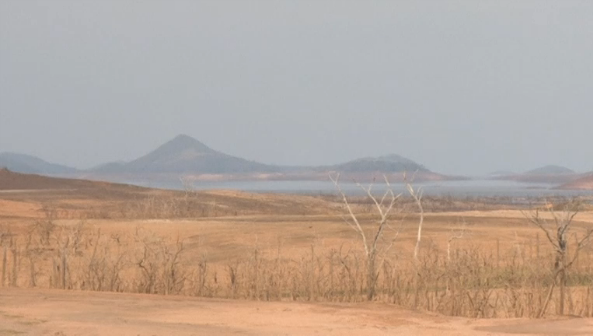
GURI, Venezuela (Reuters) – Drought has turned parts of the area behind Venezuela’s Guri dam, one of the world’s biggest, into a desert, but the government is optimistic of rain within weeks to drive the vast installation that provides the bulk of the OPEC nation’s power.
On a tour of the hydroelectric complex on the Caroni river, Electricity Minister Luis Motta told Reuters that forecasts showed a 70 to 80 percent chance of rain toward the end of April or in May to stop the waters behind the dam falling to a critical depth of 240 meters (790 feet).
Driving, hiking and rafting round the 4,600 square km (1,780 square miles) area, 57-year-old Motta pointed to unprecedented scenes revealed by the receding waters: long-sunken boats now visible; sand-dunes in previously submerged areas; cattle wandering across parched earth.
“We will continue doing everything humanly possible, and also with God’s help some good rains will come so Guri can recover, maintain service, and we can avoid extreme measures other nations are taking,” said the general, whom President Nicolas Maduro tasked with managing the electricity sector from late 2015 just as the drought-inducing El Nino phenomenon struck.
Among crisis measures, canals are being dredged to join pools now cut off by emerging land.
Motta, who also heads state power utility Corpoelec, has spent three weeks at Guri, supervising its 15,000 workers.
With about two-thirds of power consumed in homes, Venezuelans must play their part by cutting consumption, he added.
“As the Venezuelan I am, I love my country; that’s what I feel, because I know that if it does not rain and we don’t give a solution, many brothers will suffer, including my family, all of us,” Motta said.
Motta, often mocked by opposition supporters on social media, was scathing about criticism that insufficient investment, preparation and diversification of power sources were to blame.
“It looks like the Sahara desert, believe me: dunes have formed; there are dunes; there are dead fish. The situation is serious, but it is serious from the point of view of nature, we must be prepared to face it,” Motta said.
The reservoir in southern Bolivar state, which provides about 60 percent of the nation’s 16,000 megawatt power demand, hit a historic low of 243 meters (797 feet) this week.
“We are currently at a low level, the minimum was reached 244.50 meters, but we are now at a level of 243.09 meters,” Motta said.
Many Venezuelans say power and water cuts are already affecting them daily, adding to suffering from a recession, though Maduro has said he wants to avoid “painful” rationing.
Puerto Ordaz resident, Arsenia Leandro, said she has been suffering from power cuts for more than three months.
“The light has been going out for more than three months. Here, is was going out at 12 noon and returning sometimes at 4:30 in the afternoon, at 2, but today it was gone at 10 in the morning,” Leandro said.
A shop employee, Marielis Gonzalez, said the situation was critical but worse for others living further away from the hydroelectric city.
“If that’s the situation here (near the hydroelectric city) imagine those who are farther away. We should be a power and be the ones that suffer the least from lack of electricity and water but here, for example in Villa Brazil, both go out at the same time. Water and light go out together,” Gonzalez said.





